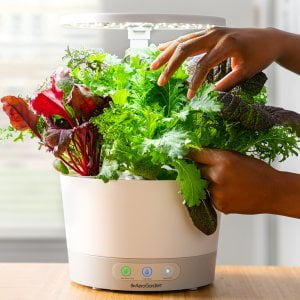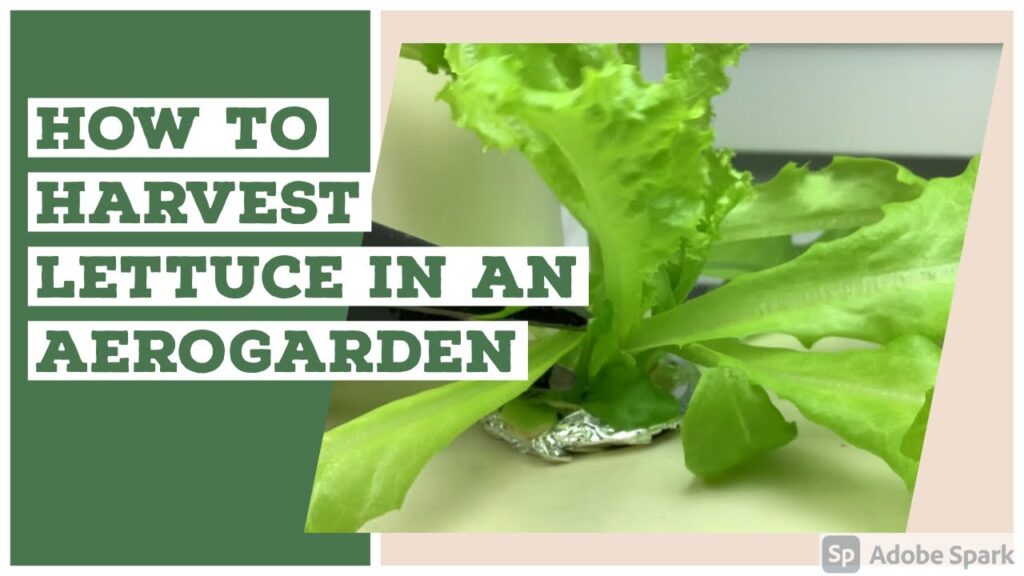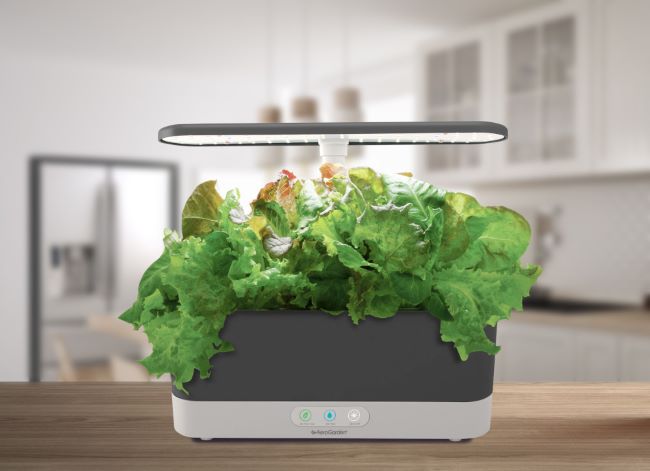So you’ve successfully grown your own lettuce in your AeroGarden, but now you’re left wondering when exactly is the best time to harvest it? Well, fret not, because in this article, we’ll guide you through the process of determining the perfect moment to pluck those leafy greens from your indoor garden. From checking the size and color of the lettuce leaves to observing their overall growth, we’ll provide you with simple tips to ensure that you enjoy the freshest and most flavorsome harvest from your AeroGarden lettuce.

Factors that Influence Harvest Time
Harvesting lettuce at the right time is crucial to ensure optimal taste, texture, and nutritional value. Several factors can influence the harvest time of lettuce, including the growth stage of the plant, the variety of lettuce, environmental factors, and the intended use of the lettuce.
Growth Stage of Lettuce
Lettuce goes through three main growth stages: seed germination, leaf development, and head formation. Understanding these growth stages is essential in determining when to harvest your lettuce.
Seed Germination
Seed germination marks the beginning of the lettuce’s life cycle. During this stage, the seeds absorb water and nutrients from the soil, resulting in sprouting. It usually takes 7 to 14 days for lettuce seeds to germinate.
Leaf Development
After seed germination, lettuce plants begin to develop their leaves. This stage is characterized by the growth of young, tender leaves from the center of the plant. The leaves gradually increase in size and become more vibrant. At this stage, you can start harvesting individual leaves for use in salads or as microgreens.
Head Formation
Not all lettuce varieties form heads, but for those that do, head formation is a critical growth stage. Varieties such as iceberg lettuce and some butterhead lettuces produce tightly packed heads that are commonly harvested as a whole. The optimal harvest time for head lettuces is when the heads are firm, compact, and reached their desired size.
Variety of Lettuce
Different lettuce varieties have varying growth patterns and flavor profiles, which also influence the harvest time.
Leaf Lettuce
Leaf lettuce varieties, including green leaf, red leaf, and oak leaf lettuce, don’t form tight heads. Instead, they produce loose leaves that can be harvested continuously throughout the plant’s growth. When harvesting leaf lettuce, you can either remove individual leaves or cut the entire plant about an inch above the soil. Harvesting young leaves will result in a more tender and mild taste, while mature leaves will have a more robust flavor.
Romaine Lettuce
Romaine lettuce is known for its elongated shape and crisp texture. Harvesting romaine lettuce typically involves cutting the entire head about an inch above the soil level. The optimal time to harvest romaine lettuce is when the leaves have grown to their full height, and the outer leaves have turned dark green.
Butterhead Lettuce
Butterhead lettuce varieties, such as Bibb and Boston lettuce, have soft, buttery leaves and form looser heads compared to iceberg lettuce. To harvest butterhead lettuce, you can either remove outer leaves individually or cut the entire head when it has reached the desired size and is firm to the touch.
Iceberg Lettuce
Iceberg lettuce is well-known for its crunchy texture and compact heads. Harvesting iceberg lettuce involves cutting the entire head when it has reached its maximum size and feels firm. The outer leaves may be slightly faded, indicating readiness for harvest. It is important to note that iceberg lettuce takes longer to mature compared to other lettuce varieties.
Environmental Factors
The environment in which lettuce is grown plays a significant role in determining its harvest time. Three primary environmental factors to consider are temperature, light exposure, and humidity.
Temperature
Lettuce grows best in moderate temperatures between 60°F and 70°F (15°C – 21°C). Extreme heat or cold can affect its growth and maturity. Higher temperatures can cause lettuce to bolt, which means it starts to produce flowers and seeds prematurely, leading to bitter-tasting leaves. Conversely, freezing temperatures can damage the lettuce leaves and affect their quality.
Light Exposure
Lettuce requires adequate light to grow and develop properly. Insufficient light can result in elongated and leggy plants. When growing lettuce indoors, provide them with at least 12 to 16 hours of light daily. If using artificial lighting, ensure the light source is positioned close enough to the plants to simulate natural sunlight effectively.
Humidity
Lettuce prefers moderate humidity levels, around 40% to 60%. High humidity can promote the growth of diseases, while low humidity can cause the leaves to wilt and dry out more quickly. Adequate air circulation is also important to prevent excessive moisture buildup, which can lead to fungus or mold development.
Intended Use of Lettuce
The intended use of lettuce also affects when to harvest. Lettuce can be harvested at different stages depending on whether you want to enjoy microgreens, salad greens, or matured lettuce leaves.
Microgreens
Microgreens are tiny, tender lettuce leaves harvested when they have developed their first true leaves. This usually occurs about 7 to 14 days after germination. Harvesting lettuce as microgreens provides a burst of flavor and can be an excellent addition to salads, sandwiches, or garnishes. These young plants are packed with nutrients and add a fresh and vibrant touch to your dishes.
Salad Greens
If you prefer larger and more substantial leaves for salads, you can start harvesting lettuce once the leaves have grown to a desirable size in the leaf development stage. Harvest the outer leaves individually, allowing the inner leaves to continue growing. This continuous harvest method allows you to enjoy fresh salad greens over an extended period.
Matured Lettuce Leaves
For those who prefer fully matured lettuce leaves, wait until the plants have developed their heads or the leaves have reached their maximum size. The outer leaves of the head lettuce should be firm, and the color should be vibrant. Harvest the entire head or individual leaves, depending on your preference and the variety of lettuce you are growing.
Signs of Readiness for Harvesting
Regardless of the growth stage, variety, or intended use, there are some common signs to look for when determining if your lettuce is ready to be harvested.
Leaf Size and Color
Lettuce leaves should reach their appropriate size based on the variety being grown. Leaf lettuce varieties will have larger leaves, while head lettuce should have tightly packed, compact heads. Additionally, the color of the leaves should be vibrant and uniform across the plant.
Texture of Leaves
The texture of lettuce leaves can indicate their readiness for harvest. Younger leaves tend to be more tender, while mature leaves can have a crisper and more substantial texture. Gently touch the leaves to assess their texture and ensure they have the desired tenderness.
Growth Habit
Observe the overall growth habit of your lettuce plants. For head lettuce varieties, the heads should be firm and tightly packed. Leaf lettuce plants should have a full and leafy appearance, with no signs of wilting or yellowing leaves. Ensure that the plants are healthy and free from pests or diseases before proceeding with the harvest.

Optimal Harvest Time for Different Lettuce Varieties
While the signs of readiness for harvesting can guide you, it’s also helpful to know the optimal harvest time for each lettuce variety.
Leaf Lettuce
Leaf lettuce can be harvested as soon as the individual leaves have reached a size of approximately 2-4 inches in length. For continuous harvesting, remove the outer leaves as needed, allowing the inner leaves to continue growing. This method allows the plant to produce new leaves, providing a continuous supply of fresh greens.
Romaine Lettuce
Romaine lettuce is typically ready to harvest when the outer leaves have grown to full length, which is usually around 60 to 70 days after planting. The leaves should be dark green and crisp. To harvest, cut the entire head about one inch above the soil level, or remove the outer leaves individually.
Butterhead Lettuce
Butterhead lettuce is often harvested when the head has formed, and the leaves are firm but still tender. This usually occurs around 45 to 60 days after planting. You can either harvest the entire head or remove the outer leaves one by one, depending on your preference and the size of the head.
Iceberg Lettuce
Iceberg lettuce takes the longest to mature, usually around 70 to 90 days after planting. The heads should be large, compact, and firm. Harvest the entire head once it has formed and the outer leaves have turned slightly faded. Ensure the head is fully developed before harvesting to avoid a bitter taste.
Harvesting Techniques
Once you’ve determined that your lettuce is ready for harvest, it’s essential to use proper techniques to ensure successful and healthy harvesting.
Selecting Leaves for Harvest
When harvesting leaf lettuce or salad greens, choose the outer leaves for harvest, as they are older and more likely to have reached their peak. As you remove the outer leaves, the inner leaves will continue to grow and provide a continuous supply of fresh greens.
Using Scissors or Shears
To avoid damaging the plants, use scissors or shears with clean and sharp blades to harvest lettuce. Cut the leaves or heads at the base, close to the soil level or stem, to minimize damage to the remaining plant. If you choose to harvest individual leaves, gently snip them off at the base without removing too many at once.
Harvesting the Entire Plant
For lettuce varieties that form heads, such as romaine, butterhead, and iceberg lettuce, you can choose to harvest the entire plant. Carefully cut the plant about an inch above the soil level to ensure you get the full head without damaging the root system.

Post-Harvest Care
Proper post-harvest care can prolong the freshness and shelf life of your harvested lettuce.
Rinsing and Drying
After harvesting, rinse the lettuce leaves or heads gently under cool running water to remove any dirt or debris. Allow them to dry thoroughly by placing them on a clean towel or using a salad spinner. Excess moisture can lead to faster decay, so ensure the lettuce is completely dry before storing.
Storage and Shelf Life
To extend the shelf life of your harvested lettuce, store it in a cool, dry, and well-ventilated area. Wrap the leaves loosely in a paper towel or place them in a breathable bag to prevent wilting and maintain freshness. Avoid storing lettuce near fruits or vegetables that produce ethylene, as this gas can accelerate the lettuce’s decay process.
Enjoying Your Harvested Lettuce
After putting in the effort to grow and harvest your lettuce, it’s time to enjoy the fruits of your labor. Here are a few ideas for how to savor your freshly harvested lettuce.
Recipes and Meal Ideas
Lettuce is a versatile ingredient that can be enjoyed in various recipes and meal preparations. Use your harvested lettuce leaves to create delicious salads, wraps, sandwiches, or as a topping for burgers or tacos. Experiment with different dressings, toppings, and combinations to find your favorite way to enjoy your homegrown lettuce.
Growing a New Batch
Once you’ve harvested your lettuce, don’t forget that you can start the growing process again and enjoy a new batch of fresh greens. With the right techniques and care, you can continue to grow lettuce throughout the year and savor the taste of homegrown produce.
In conclusion, understanding the factors that influence harvest time, such as the growth stage, variety, environmental conditions, and intended use, is essential for successfully harvesting lettuce. By paying attention to the signs of readiness, using proper harvesting techniques, and practicing post-harvest care, you can enjoy the best-tasting lettuce from your AeroGarden. Whether you prefer microgreens, salad greens, or matured lettuce leaves, growing and harvesting your lettuce can be a rewarding and delicious experience.




